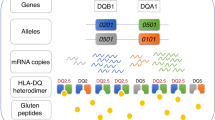Summary
This multi-centric cohort study [1] from four countries followed a group of infants with the HLA haplotype DR3-DQ2 or DR4-DQ8, from birth through the first few years of life; seeking the appearance of antibodies to tissue transglutaminase (tTG) (labeled as celiac disease autoimmunity), and development of celiac disease. This was part of a larger study evaluating the development of type 1 diabetes in a cohort of infants with genetic susceptibility (based on carrying the HLA haplotype DR3-DQ2 or DR4-DQ8) [2]. Over a median follow-up duration of nearly five years, the investigators reported 12% prevalence of celiac disease autoimmunity and 3% prevalence of celiac disease. They also identified that the respective risks of these two outcomes varied by the HLA genotype: 26% and 11% with homozygosity for DR3-DQ2 haplotype; 11% and 3% with DR3-DQ2/DR4-DQ8 haplotype; 8% and 3% with DR4-DQ8 homozygosity; and 3% and <1% among those with DR4-DQ8/DR8-DQ4 haplotype. There was statistically significant higher risk of celiac disease autoimmunity and celiac disease in infants from Europe (highest risk in Sweden), female gender, and those with family history of celiac disease.
Similar content being viewed by others
References
Liu E, Lee H, Aronsson CA, Hagopian WA, Koletzko S, Rewers MJ, et al. Risk of pediatric celiac disease according to HLA haplotype and country. New Engl J Med. 2014;371:42–49.
Hagopian WA, Erlich H, Lernmark A. The Environmental Determinants of Diabetes in the Young (TEDY): Genetic criteria and international diabetes risk screening of 421000 infants. Pediatr Diabetes. 2011;12:733–43.
Murch S, Jenkins H, Auth M, Bremner R, Butt A, France S, et al. Joint BSPGHAN and Coeliac UK guidelines for the diagnosis and management of coeliac disease in children. Arch Dis Child. 2013;98:806–11.
Makharia GK, Verma AK, Amarchand R, Bhatnagar S, Das P, Goswami A, et al. Prevalence of celiac disease in the northern part of India: A community based study. J Gastroenterol Hepatol 2011;26:894–900.
Dube C, Rostom A, Sy R, Cranney A, Saloojee N, Garritty C, et al. The prevalence of celiac disease in average-risk and at-risk Western European populations: A systematic review. Gastroenterology 2005;128:S57–67.
Holmes GK. Screening for coeliac disease in type 1 diabetes. Arch Dis Child. 2002;87:495–8.
Atherton R, Ross A, Jessop F, Williams R, Heuschkel R, Zilbauer M. Coeliac disease in children with type 1 diabetes — Are current guidelines proving difficult to implement in practice? J Pediatr Gastroenterol Nutr 2014 Jul 23. [Epub ahead of print].
Rubio-Tapia A, Van Dyke CT, Lahr BD, Zinsmeister AR, El-Youssef M, Moore SB, et al. Predictors of family risk for celiac disease: A population based study. Clin Gastroenterol Hepatol. 2008;6:983–7.
Sollid LM, Thorsby E. The primary association of celiac disease to a given HLA-DQ alpha/beta heterodimer explains the divergent HLA-DR associations observed in various Caucasian populations. Tissue Antigens. 1990;36:136–7.
Sollid LM, Markussen G, Ek J, Gjerde H, Vartdal F, Thorsby E. Evidence for a primary association of celiac disease to a particular HLA-DQ alpha/beta heterodimer. J Exp Med. 1989;169:345–50.
Hadithi M, von Blomberg BM, Crusius JB, Bloemena E, Kostense PJ, Meijer JW, et al. Accuracy of serologic tests and HLA-DQ typing for diagnosing celiac disease. Ann Intern Med. 2007;147:294–302.
Husby S, Koletzko S, Korponay-Szabó IR, Mearin ML, Phillips A, Shamir R, et al. European Society for Pediatric Gastroenterology, Hepatology, and Nutrition guidelines for the diagnosis of coeliac disease. J Pediatr Gastroenterol Nutr. 2012;54:136–60.
Rubio-Tapia A, Hill ID, Kelly CP, Calderwood AH, Murray JA; American College of Gastroenterology. ACG clinical guidelines: Diagnosis and management of celiac disease. Am J Gastroenterol. 2013;108:656–76.
Klapp G, Masip E, Bolonio M, Donat E, Polo B, Ramos D, et al. Celiac disease: The new proposed ESPGHAN diagnostic criteria do work well in a selected population. J Pediatr Gastroenterol Nutr. 2013;56:251–6.
Yachha SK, Poddar U. Celiac disease in India. Indian J Gastroenterol. 2007;26:230–7.
Kaur G, Sarkar N, Bhatnagar S, Kumar S, Rapthap CC, Bhan MK, et al. Pediatric celiac disease in India is associated with multiple DR3-DQ2 haplotypes. Hum Immunol. 2002;63:677–82.
No authors listed. Critical Appraisal Skills Programme. 12 questions to help you make sense of a cohort study. Available from: http://www.caspinternational.org/mod_product/uploads/CASP_Cohort_Studies_Checklist_14.10.10.pdf. Accessed August 16, 2014.
Senapati S, Gutierrez-Achury J, Sood A, Midha V, Szperl A, Romanos J, et al. Evaluation of European coeliac disease risk variants in a north Indian population. Eur J Hum Genet. 2014 Jul 23. doi: 10.1038/ejhg.2014.137. [Epub ahead of print]
Kumar N, Kaur G, Tandon N, Kanga U, Mehra NK. Genomic evaluation of HLA-DR3+ haplotypes associated with type 1 diabetes. Ann N Y Acad Sci. 2013;1283:91–6.
Kaur G, Kumar N, Szilagyi A, Blasko B, Fust G, Rajczy K, et al. Autoimmune-associated HLA-B8-DR3 haplotypes in Asian Indians are unique in C4 complement gene copy numbers and HSP-2 1267A/G. Hum Immunol. 2008;69:580–7.
Olivares M, Neef A, Castillejo G, Palma GD, Varea V, Capilla A, et al. The HLA-DQ2 genotype selects for early intestinal microbiota composition in infants at high risk of developing coeliac disease. Gut. 2014;Jun 17:doi: 10.1136/gutjnl-2014-306931. [Epub ahead of print]
Murray JA, Moore SB, Van Dyke CT, Lahr BD, Dierkhising RA, Zinsmeister AR, et al. HLA DQ gene dosage and risk and severity of celiac disease. Clin Gastroenterol Hepatol. 2007;5:1406–12.
Van de Wal Y, Kooy Y, Van Veelen P, Vader W, Koning F, Peña S. Coeliac disease: it takes three to tango! Gut. 2000;46:734–7.
Srivastava A, Yachha SK, Mathias A, Parveen F, Poddar U, Agrawal S. Prevalence, human leukocyte antigen typing and strategy for screening among Asian first-degree relatives of children with celiac disease. J Gastroenterol Hepatol. 2010;25:319–24.
Yachha SK. Celiac disease: India on the global map. J Gastroenterol Hepatol. 2006;21:1511–3.
Author information
Authors and Affiliations
Corresponding authors
Rights and permissions
About this article
Cite this article
Mathew, J.L., Yachha, S.K., Sarma, M.S. et al. Risk of pediatric celiac disease according to HLA haplotype and country. Indian Pediatr 51, 733–737 (2014). https://doi.org/10.1007/s13312-014-0492-y
Published:
Issue Date:
DOI: https://doi.org/10.1007/s13312-014-0492-y



